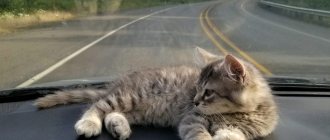We always take the pet with us or leave someone in the car who will open the window or turn on the air conditioner.
In addition, in hot weather, it is recommended to take with you a special cooling mat for cats and dogs for your pet to lie on.
Transport equipment and accessories
The modern market for pet products is so extensive that you can find everything you need for almost any situation. Traveling with cats in a car has long been a part of some people’s lives, so experts have come up with and developed many devices to facilitate the process of transporting an animal.
Cat in the car
Note! It is not recommended to carry a cat in a car in your arms. This can be resorted to only if the animal is already familiar with the interior of the car, has become accustomed to it, and the trip promises to be short.
When traveling in a car, you need to purchase a special cat harness and keep it on throughout the entire journey. A leash is attached to the harness, the other end of which is tied to some object in the cabin. This is a necessary safety measure. The cat should be able to sit comfortably on the seat, but should not be allowed to move freely around the car.
Such devices are suitable for cats that can behave calmly in a car. But still, the best and safest accessory for transporting cats is a carrier bag. This is a special “container” that allows the cat to move around calmly in it, but at the same time eliminates the possibility of the animal escaping.
The carrying bag must meet the following requirements:
- The presence of holes that allow air to pass through (this can be a mesh wall or grille).
- The size of the container should correspond to the size of the cat - the animal should not be cramped.
- The presence of special holes for securing the leash.
- Stable bottom.
- Reliable walls and locks.
You should also get a small bed in advance. You should not place the cat directly at the bottom of the container.
A cat can be trained to travel without a carrier
What to transport your pet in
If you are planning a trip on public transport, according to the rules, you must transport your animal only in a standard-sized carrier. My experience suggests that it is best to transport cats only in a special carrier. Believe me, this is as convenient and safe as possible for both the animal and the owner.
But there have been times in my life when there was no carrier or it was broken, and then I used improvised items. An old backpack and a cloth bag came to the rescue.
For transportation in a car, it is best to use frame carriers (not fabric houses). Special seat covers are sold with a built-in frame mesh, inside which the animal is placed. Some owners attach the cat with a harness to the seat belt in the back seat if the pet is very stressed when traveling in a closed container.
What to take with you
- When traveling with a cat or dog, be sure to take with you disposable diapers, wet wipes, garbage bags, and, if necessary, a motion sickness remedy selected by a veterinarian.
- Be sure to take a supply of clean drinking water for your pet and a bowl, food and treats, dry food - even for a short trip to calm the animal.
- Toys, a spare collar and a leash will not be superfluous.
- You should always have a bandage, plaster, and antiseptic in your first aid kit.
Access to water
It is not at all necessary to feed the animal along the way if the journey takes less than 12 hours. Although you can give a treat to make the cat feel comfortable. However, you should not feed it fully so that the cat does not vomit or have to go to the toilet.
But access to water should be available all the time. You can attach a special travel drinker to the wall of the carrier, which does not splash water. Or you can offer your cat a drink from a special bottle for dogs and cats every 30 minutes.
What happens to a cat when it suddenly travels?
Transporting dogs in a car over long distances
An unsuspecting cat who is suddenly thrust first into a carrier and then into a car is inevitably faced with extreme stress. Therefore, owners should know in advance how cats cope with the road in the car.
A cat caught by surprise is not ready for such a test, which can negatively affect its emotional state. Especially when it comes to adults and elderly animals. It is easier for young people to adapt to changes than for adults.
Against this background, the cat may lose its appetite. Being in a prolonged state of fear will make her intimidated, nervous, perhaps even aggressive. Those who have ever carried cats in a car are well aware of the problems with the toilet: the cat may shit in the car or start burping.
To avoid such problems, owners should think in advance about how to prepare their cat for traveling by car.
What you need to transport a cat by train
Which car is suitable: passenger or baggage
The only passenger carrier in our country is Russian Railways. If such a move is planned, it is better to find out in advance the existing rules of this state company in the field of transporting animals.
If you are using a shared carriage where the passenger is seated, you will need to pay extra for the cat and present a transportation ticket (receipt). There are other types of wagons that have different requirements.
Table of conditions for transporting animals in Russian Railways cars.
Cost of transporting cats on a train
If we are talking about high-speed trains, you will also have to pay extra. The “swallow” charges a fixed fee of 150 rubles. In Sapsan it is already included in the ticket price.
Transportation on long-distance trains
When transporting an animal, the owner must ensure sanitary and hygienic requirements, as well as the safety of other passengers.
Long-distance travel is considered to be a route longer than 700 km. The cost of transporting a cat will depend on the distance, for example, for a distance of more than 12,000 km the cost will be 3,000 rubles. To ensure your pet’s comfort, you must fulfill a number of requirements:
- ensure constant access to water;
- carry anti-motion sickness pills;
- If possible, at stations with a large parking lot, take the container with the animal into the fresh air and give her the opportunity to go to the toilet.
Also, when moving long distances, it is worth considering the cat’s diet. It is optimal to choose dry ready-made food. You should not feed your pet too often.
Transporting cats unaccompanied
- cage or special carrier;
- veterinary documents;
- food, water, hygiene products for the cat.
The cost of such a service is determined by the distance. During the entire journey, the animal will be under the supervision of train staff.
How to prepare your cat for a trip
How to transport a cat on a train: Russian Railways rules
Preparatory activities should begin no later than two months before the planned trip. The first stage is vaccination. It must be preceded by treatment for worms (10 days before vaccination).
3-4 weeks after the first vaccination, the animal is given a second vaccination. After this, you must wait for the incubation period (quarantine), which lasts about two weeks. During this time, the cat should develop and strengthen its immunity.
Only after these procedures can you organize a long trip by car.
You need to accustom your cat to the car from childhood
What and how to feed your pet while traveling
The cat's food during the trip should be calculated based on the duration of the intended trip. For example, if you are expecting a move that will take no more than 5-7 hours, then you don’t have to feed the animal in the car to avoid unpleasant situations with motion sickness.
When the journey takes a day or more, it will be necessary to prepare rations for the four-legged passenger. It is recommended, if possible, to take with you on the road the food that the cat is accustomed to. But these should not be strong-smelling or perishable products. The ideal option would be dry or wet food. Feeding regimen: small portions of food several times a day (up to 4 feedings).
Note! In addition to food, the cat should have constant access to fresh water. Especially when it comes to traveling in hot summer weather.
Accompanying documents
It is clear that you will not need documents to travel to the country or on another short trip. However, when moving long distances, you will have to worry about having special documents.
You need to have a veterinary passport with you, which indicates that the animal has all the necessary up-to-date vaccinations. Vet. a passport, unlike a pedigree, can be obtained without any problems at the nearest veterinary clinic. Even outbred domestic cats should have it and it is done at any age.
If you are planning a long trip that involves traveling abroad, you will need more documents. Each country requires its own list of required documents and you need to get acquainted with them individually. When traveling abroad, you may need to have a chip, a certificate of absence of rabies, a health certificate (international standard), an import declaration and some other documents.
Frequently traveling cats are not afraid in the car
Preparation for transportation
Before transporting an animal, you need to take care of its comfort and health. At these moments, the pet is not protected from infections and stress. Transportation is especially dangerous for animals that live permanently in an apartment and do not have access to the street.
Deworming and vaccination
Cats' immune systems can be attacked by infections while they are outside, so deworming should be done in advance. If your pet gets sick, you won't have to deal with multiple illnesses at once, and you will also minimize the unexpected manifestations of illnesses that stress causes, such as some types of lichen. Read about how to treat lichen in my other article.
When planning a long-distance trip, carry out the necessary procedures in advance and check the vaccination schedule so that the treatment period does not coincide with the time of travel.
Veterinarian consultation
Contact your veterinarian to find out which motion sickness tablets are available for your pet. Regardless of the choice of transport for the trip, as well as its duration, the animal may feel bouts of nausea and vomit.
If you know that your cat is impressionable, has a hard time with changing surroundings, or can be aggressive, purchase calming drops. They begin to be given approximately two weeks before the trip. Herbal medications are not addictive, but the need for their use and dosage should be clarified with your doctor.
Comfort and safety
Prepare the cat carrier in advance: check that the lock is working properly and that the lid is tight. If you have a regular plastic baby carrier, put some rags inside and buy some disposable diapers. Regardless of the duration of the trip, the call of nature has not been canceled, and during periods of stress the animal may defecate unexpectedly.
If you are planning a long trip by car or public transport, take a cat litter tray, cleaning bags and wet wipes with you to take care of your cat's hygiene.
On a trip, it is recommended to take your pet’s favorite things that smell like home: toys, bedding, dishes.
Purchase or prepare a harness and leash. During stops, you can offer your pet a walk, stretch and go to the toilet. A leash is important because a cat may try to run away and hide out of fear.
I have seen owners of large cats, in particular Maine Coons, who prefer to go grocery shopping or to the veterinary clinic, keeping their pet on a leash.
Experienced owners hang a tag on the cat's collar with its name and the owners' phone number. Such a minor detail will help save your nerves in the future.
We provide food and drink
Many owners prefer not to feed their pet on the road, but if the journey is long and the animal is accustomed to eating at a certain time, then you should worry about providing it with food and water.
The best food option. When choosing food, it is better to give preference to dry food or small packages with pieces in sauce, canned food. They will not spoil even if there is no refrigerator, and the cat will not get food poisoning. Fresh water is a must. An animal is thirsty because:
- experiences stress and “sweats” a lot;
- loses fluid during vomiting during motion sickness;
- overheats inside the car;
- eats dry food.
When to feed?
If the trip takes a little time, then it is better to feed the cat 30-60 minutes before departure.
On a long journey, the animal is fed according to a schedule or when the pet wants to eat. Water must be in the access area at all times. For convenience, you need to take with you bowls for food and water, from which the cat eats at home. Familiar containers will calm the cat.
Possible problems and advice from experienced travelers
Microchip implantation
The main idea of chipping is to make it easier to find “lost items” so that if found, they can be returned to the owner. Also, all information about a given belly is recorded on the chip, including its vaccinations, diseases and other data.
What does a cat need on the road?
In order for your pet to survive a long trip, you need to have some items with you. Be sure to stock up on the following:
All of these items will be useful, especially during a long trip.
I recommend: Furminator for cats and kittens: what is it, how to choose and use
Is a container required for transportation?
A bag for transporting cats is a must, regardless of the chosen transport. It is not recommended to take out an animal while traveling, since in a state of fear it can simply run away, bite, scratch and escape from your hands.
The nuances of transporting kittens
Sedatives for cats
Using sedatives will reduce your cat's stress. It is advisable to coordinate the choice of a specific drug with your veterinarian. If you plan to travel by plane, sedatives for cats during transportation can be dangerous.
An overdose of the drug can also only cause problems, and sometimes even cause death.
How to prepare a cat for flight
For several days, the cat’s food should be limited, but not completely. Access to water must remain unrestricted. It is worth preparing a carrier, toys and other necessary items in advance.
Should you feed and water your cat before and during the flight?
It is better not to feed the animal during the day or during the flight. The cat is under stress and therefore will not be interested in food. The last feeding should be four hours before departure.
Possible problems during the trip
If the owner is thinking about how to transport a cat in a car without a carrier, then he should familiarize himself with the list of problems that may arise during the trip.
How to remove a cat from a tree: an effective method
Cats tend to be afraid of unfamiliar surroundings. Therefore, even a calm and balanced animal can forget about exemplary behavior and scratch the owner’s hands and exposed parts of the body not out of malice, but out of fear.
Often there are problems with the toilet. You should take care in advance about the availability of a tray, bag, filler and, of course, be patient, especially when it comes to traveling with a kitten. Pets accustomed to walking can be periodically taken outside to do their business.
Note! Wondering how to transport a cat in a car over long distances, some owners decide to sedate it with sedatives for the duration of the trip. This is a good way for owners of lively cats.
Buses
Transportation on a bus within the city is permitted only if the animal is in a bag, basket or any other container. Regardless of the duration of the trip, you must take with you a veterinary passport with notes on the vaccination performed. The rabies vaccination must be done at least one month before the trip and no more than eleven months ago. It is permissible to transport a cat on a bus only if the animal is clinically healthy, you should take care of the pet’s appearance and pre-treat it with a complex anti-parasite remedy (diseases of internal organs and injuries do not count, this includes infections and parasitic infestations that pose a danger to others).
There is no need to buy a ticket for an animal; small pets travel on buses as the passenger’s personal luggage. But for your own convenience, if the trip lasts several hours, you can buy a seat next to you and put the carrier on the seat, rather than holding it in your hands.
The container has additional requirements: walls made of durable material, good ventilation, reliable locks on the door. And the point is not to ensure the comfort of the animal (transport companies are not concerned with this), but about the safety of others: the cat should not be able to get out, should not stick its paws or muzzle through the carrier bars, and should not contaminate the transport with feces or hair.
If your cat gets sick in the car
Some cats get carsick. Signs that this is happening to your pet include:
- drooling and constant licking of the mouth;
- vomit;
- the cat breathes through its mouth.
2-3 hours before the start of the trip, do not feed the cat so that it has nothing to vomit. But if this does happen, you should always have a large amount of wet wipes ready to clean the interior.
In addition, you can use cat tablets against motion sickness, which are sold in veterinary pharmacies.
Measures against violators of animal transportation rules
For violation of the conditions for transporting cats abroad and in Russia, penalties may be applied to the owner.
To ensure that traveling with your beloved pet is not burdensome, you must comply with the transportation rules. A passenger who has not completed the required documents for transporting an animal may simply not be allowed to travel.
The conditions for transporting cats and small pets are regulated by the Code of Administrative Offenses of the Russian Federation. If you fail to comply with the carry-on baggage standards (carrying a cat falls into this category), the culprit will answer under Article 11.19 and pay a fine of 100 rubles. He will also be required to eliminate the violation.
Experienced travelers assure that railway and airline employees are always ready to help, correct and polite. You can safely go on a long journey, calmly transport your pet, without fear of difficulties.
Contraindications to the use of sedatives
Do not forget that any remedy, even homeopathic, has a number of contraindications. Therefore, it is still worth giving certain medications, as mentioned above, after consulting a veterinarian. In addition, the use of sedatives during pregnancy, feeding kittens, and under the age of one year will be absolutely prohibited. Contraindications for health reasons include: renal or genitourinary pathologies, problems with blood pressure and vision, periods of illness of the animal. Also, under no circumstances should you give such a popular valerian to cats. Along with catnip, it causes narcotic intoxication and harms the health of the animal.
But it can be easier
Do you want to know how to make an intercontinental flight without any vaccinations, passports, documents, certificates and other customs hassles? Ask the cat Bisa. A seven-year-old Persian cat, who accidentally climbed into her owner's travel bag and fell asleep there, made a 3,400-mile flight from Egypt to England. The bag with the “live stuffing” safely passed the security system at Cairo airport (!) and, along with many different trunks and suitcases, arrived in the luggage compartment of the plane at Heathrow.
After the flight, Bisu feels well. Her owner, after staying with her sister, returned home to Egypt. But her pet had to spend a long time in an animal center in Chesterfield to undergo quarantine, since the official method of return is much more complicated...
What to do to prevent the omen from coming true
If a sign carries a negative connotation, do not be upset; sometimes the effect of a sign can be minimized. First, you need to calm down and remember that signs do not come true in 100% of cases. There are many ways to avoid the bad effects of omens:
- Use the anti-omen. You can knock on wood, spit over your left shoulder three times, look in the mirror;
- Try to mentally “erase” the sign. In consciousness, concentrate on the negative moment and forget it. You can write a superstition on paper and set the paper on fire. With ashes, everything bad is neutralized;
- Devalue the sign. You should try with all your might not to believe in the effect of the sign, to convince yourself of it.
Some people come up with their own effective ritual to avoid the influence of superstitions. There are many ways, the main task is to switch your attention from a negative attitude to a positive one.
Preparing the cat for the trip
Before your trip, you need to take care of the most important thing - the mustachioed traveler. We put him on a small diet : it’s better for him not to eat 3-4 hours before the trip. This rule does not apply to water: you can give it to your pet. Cats can tolerate it for 24 to 48 hours, so it’s unlikely that a puddle will appear in the carrier.
If your animal often gets nervous while traveling, you should visit the veterinarian in advance . He can prescribe sedatives so that the pet does not worry. Opinions about such drugs are controversial in the veterinary community, but in some cases their use may be justified.
Never give medications without your doctor's advice. This is especially true for pharmaceutical products intended for people. It is also a good idea to check how your cat reacts to the drug in advance to avoid any surprises along the way. This issue should also be discussed with your veterinarian.
The influence of the season on the meaning of the sign “the cat sat on the car”
Cats can be found on the street in both heat and cold, but the meaning of the superstition changes depending on the time of year:
- Spring. There is an opinion that in the spring a cat on a car means possible malfunctions; it is worth checking the condition of the car and protecting yourself from danger;
- Autumn. If a cat climbs onto a car in the fall, it means it feels the impending cold. The weather will soon change, leading to a general cooling;
- Winter. A cat in winter climbs onto a car and licks its tail - to a snowstorm and blizzard;
- Summer. In the summer, a cat in a car brings good luck. The exception is black cats; according to signs, they are considered a harbinger of trouble at any time of the year.
How to ensure comfortable movement of your pet
A cat can accompany its owner in all means of transport: car, train and plane. Traveling by car or train usually takes a large number of hours, so the owner is obliged to provide the cat with comfortable conditions while traveling:
Carrying
A cat carrier will serve as a temporary shelter for the cat and provide the owner with control over its movement. The carrier can be soft or hard plastic. Plastic carriers with a metal door more guarantee that the pet will not get out of it and will be safe.
The size of the carrier should allow the animal to sit, turn around and stretch its legs in a lying position. For airplane travel, airline regulations have special restrictions on the size of pet carriers.
It is advisable that the cat is familiar with the carrier before the trip, because cats do not like surprises and unfamiliar objects. You can put a towel familiar to the cat, a small blanket or an old T-shirt of the owner in the carrier. Stress can cause a cat to wet itself, so the bottom of the carrier should be covered with a moisture-absorbing diaper.
Food and drink. How to feed on the road
On a long journey, your pet must be provided with access to food and clean water. To reduce the discomfort of transportation and reinforce the new experience with something good, you can give your cat her favorite treat.
Do not be surprised if a cat refuses food and water; in a stressful situation, animals may not drink during the day, and not eat for up to 3 days. This is normal and there is no need to force the animal to eat or drink.
Tray
If the journey takes more than a day, then the cat needs to be provided with access to its litter box. The tray needs to be installed in a place that is safe for the cat (quiet, secluded). The tray should contain a small portion of used litter so that the cat can easily recognize its scent.
Movement
The cat should be able to stretch its paws every 3 hours and sooner or later it will want to explore its surroundings. If the cat is calm, then it can be let out of the carrier to walk around the inside of a car or train compartment, but on the condition that it is wearing a harness with a leash. It is strictly not recommended to let a cat out without a harness: any loud sound or sudden movement can frighten the animal and it can run away and get lost.
Sedative for cats on the go
10-15 days before the trip, it is recommended to give the cat sedatives (drops, tablets) based on herbal ingredients. They do not contain harmful or potent substances, so the effect is cumulative.
For cats that do not exhibit aggressive or uncontrollable behavior while on the move, you can limit yourself to a catnip toy or an herbal spray that can be applied to the bedding in the carrier.
For those animals that panic and destroy everything around during transportation, it is possible to use tranquilizers
They should be given with caution and depending on the weight of the animal. Before you buy a tranquilizer, you need to consult a veterinarian who will prescribe the appropriate drug.
Veterinary passport for a cat
Currently, a veterinary passport is not required to transport pets within Russia by car or train. It is only needed to travel by plane.
In any case, it is better to take your pet’s medical card or veterinary passport on the road to continue veterinary care at your new place of residence. It would be better if, just in case, the owner has the phone number of the veterinarian who previously saw the cat.
Comfortable transportation conditions will make moving easier for both the cat and its owner. We also recommend that you read the article about cat carriers and tips for choosing one.
First thing
First of all, make sure that it is not easier to leave the cat at home. Here are some examples when it is better not to disturb a cat:
- The cat has nowhere to live. Imagine that you are going to visit relatives, and they are allergic to cats. It is easier to leave a cat in a hotel in your hometown than to rent out a hotel while visiting.
- Long quarantine. When crossing some borders, animals have to remain in quarantine for up to six months.
- Nervous character of the animal. Some cats are simply pathologically afraid to leave the house. Especially if they have never left the apartment, which is not uncommon now.
If your cat is an avid traveler, and the same cat lovers without a hint of allergies are waiting for you at the place of arrival, get ready for a trip. Cats have no business lying on the sofa!
To take or not to take?
If you are planning a trip for a short period of time, then the animal can be left either in the care of neighbors, relatives, or taken to a hotel. However, in the first case, there is not always someone who agrees to look after or take in, and in the second, the whole issue may come down to the cost of maintenance. After all, hotels charge quite a lot for furry friends.
As for long journeys, in this case it is important to think about the mental state of the animal. Free and unapproachable, cats are too attached to their owner
However, they also get very used to their home environment, so changing places can be a huge stress. The most peaceful and calm of them may begin to behave aggressively and do minor mischief, be it markings on the walls of a new home or regularly walking past the toilet. Cats experience a short separation quite calmly, but during a long one they can become very sad.
As for dogs, what is most important to them is the person. They can follow their owner anywhere and anytime. However, their transportation requires additional measures and difficulties.
It is worth taking into account such an important point as the reluctance of owners of rental housing to accept guests with pets. Therefore, the issue should be clarified and agreed upon in advance.
Another important point is the age limit. EU countries and the UK are not willing to accept furry guests under three months old. Malta and the Maldives generally do not want to see strangers, so entry into these countries is prohibited with a pet. If you are planning a trip to Uruguay or Saudi Arabia, then in this case you cannot take only birds with you. In addition, there is a restriction on traveling with animals: after 10 days, tourists must leave the territory of the host country.
Watch the video about the rules for transporting animals:
Where did the superstition “the cat sat on the car” come from?
Most signs have their origins in ancient customs and historical events. For example, previously mirrors and salt were expensive, so spilling salt and breaking a mirror was considered bad luck.
Superstitions associated with cats also have historical background. In the Middle Ages, people died en masse from epidemics, infections carried by rats, including cats. Therefore, they were afraid of cats and tried to avoid them.
Each country has its own signs, they are associated with generally accepted traditions and way of life. In North Africa they believe that a black cat will bring happiness; among the Slavs it is a symbol of evil spirits and dark magic. In one country, a cat in a car is a sign of joy, in another it is a sign of misfortune. Signs are formed in the minds of the people gradually, and their meaning is transmitted and modified from generation to generation.
To believe signs or not is up to each person. You can find a logical explanation for the belief, or you can intuitively put sacred meaning into it. The sign “a cat sat on a car” was formed recently; this superstition does not have a rich past. Depending on the situation, different interpretations of the sign are possible, both positive and negative. The negative influence of superstition can be avoided, the main thing is your internal positive attitude, belief in the good and attentiveness to your safety.
Rules for the international transport of animals
Pets are allowed for air transportation only with prior approval from the international air carrier. You must inform us that you want to take your cat on board when ordering your ticket.
The main document for moving animals is an international veterinary certificate(!)
To leave the country with an animal you will need the following documents:
Veterinary certificate (certificate in form No. 1). When crossing the border, the veterinary certificate is replaced with an international veterinary certificate (usually a veterinary certificate is issued in exchange for a veterinary certificate at the airport).
Export license. It can be issued by any felinological club. The correctness of paperwork on the day of departure is checked by customs veterinary control.
If you check a cat as luggage, copies of its documents and the owner's address are included with the cage, and a number of international airlines only accept documents in English.
In addition, each airline has its own additional conditions and restrictions that should be clarified before departure.
When crossing borders in different countries, other additional documents may be required (!). Therefore, find out in advance what requirements the country whose border you are going to cross imposes on the import of animals (for example, animals imported into the UK and Iceland are required to undergo quarantine for six months in specialized institutions, and to enter some countries an animal’s blood test is required for the presence of antibodies to the rabies virus, etc.). You can get information from the consulate of the country you are going to visit, and if you are traveling in transit, then from the consulate of the countries you are transiting through.
Even if all the cat’s documents are in perfect order, the carrier has the right not to take on board a dirty or foul-smelling animal. In addition, the carrier is not responsible if the pet gets sick on the way or if the country of arrival refuses to accept it.
Well, that's all, business! Bon Voyage!
How to transport a cat on a plane
Most airlines allow cats and dogs, but their requirements may vary.
It is not true that pets fly in the cargo hold along with luggage. Animals are placed in a special warm compartment. At the same time, a cat and a dog cannot fly on the same plane, so a ticket with an animal must be booked in advance. The carrier must confirm whether your cat can be carried on this flight, so book your ticket as early as possible.
You can take your pet into the salon in a container whose total weight does not exceed 8 kg. This means that the cat will most likely fly with you. You cannot take it out of the carrier.
Before boarding, the cat must undergo veterinary control, so arrive at the airport early. At the veterinary station you need to present all the documents, and the employee will make sure that the pet is healthy and safe for others. You will be given a permit and you will be able to board with your cat.
Aeroflot clarification
Transport
Animals can be transported on almost all types of passenger transport. True, the size and type of animal matters. Thus, almost all airlines allow only cats and dogs (up to 5–8 kg) to be carried in the aircraft cabin, and only 1 to 4 animals at a time.
During the flight, the pet carrier is located under the seat in front, where the pet must remain during takeoff and landing. Directly during the flight, the animal can sit in your arms, however, of course, if this does not threaten the comfort of the surrounding passengers, because among them there may be people suffering, for example, from an allergy to wool or those who are terrified of any dogs.
If your pet is not included in the “cabin” standards, you will have to part with it during the flight: it will travel in a special container placed in the luggage compartment.
Be sure to remember that the airline must be notified of your four-legged companion. Therefore, when purchasing a ticket, you must inform that you are flying with a dog or cat: then you will be “issued” with a corresponding ticket, the cost of which is calculated as the cost of excess baggage, based on weight, but at first class rates - approximately from 5 to 14 euros per kilogram. The exception is guide dogs accompanying blind and deaf passengers. In this case, they are transported free of charge.
Transportation and cages must comply with the international IATA standard. The size of the container should be selected so that the dog or cat can stand in it and freely turn 360 degrees. The design and material of the container must protect the animal from damage, the bottom of the container must be waterproof and covered with absorbent material, the container must be securely closed with a lock that prevents spontaneous opening of the container in flight.
A special carrier, container or basket will also be required when traveling by train. Small pets, dogs and birds must be transported in “containers” that fit in areas designated for carry-on luggage. The size of such a place in the sum of three dimensions should not exceed 180 cm.
Transportation of animals up to 20 kg is paid for as one piece of baggage, and those weighing more - with payment for the actual weight. Large animals (weighing more than 20 kg) should be transported in baggage cars in special containers with the appropriate dog ticket. If your solvency allows, you can travel with your pet in a separate compartment - naturally, with payment of the full cost of all seats.
It is allowed to travel with animals on some ferry lines, however, even in this case, you must notify the carrier that you are traveling with a pet. Then you will be provided with an appropriate cabin. By the way, on some ferries there are even special places for walking dogs - the so-called dogs corner.










